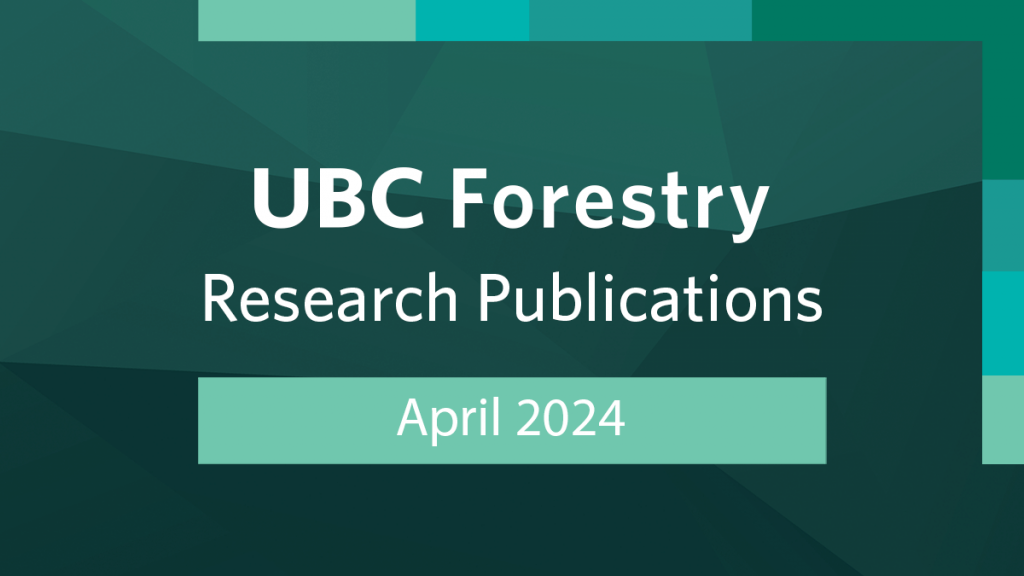
Discover the cutting-edge research shaping the future of forestry! Our faculty members and graduate students are at the forefront of innovation, addressing critical challenges and exploring sustainable solutions to ensure the health and vitality of our forests.
Here is a look at the research publications from UBC Forestry this month.
Department of Forest and Conservation Sciences
Physiological and biochemical response analysis of Styrax tonkinensis seedlings to waterlogging stress
Authors: Hong Chen, Chao Han, Zemao Liu, Robert D. Guy, Fangyuan Yu
Climate change is making floods worse in areas south of the Yangtze River, making it harder to grow Styrax tonkinensis trees there. We studied why these trees struggle with too much water by looking at their chemical makeup during different seasons. We tested them by flooding their pots for 4 or 12 days in summer and winter. We found that in summer, their roots couldn’t absorb water well because of hormonal imbalance and the accumulation of fermentation products. This caused damage to the roots and leaves, making them wilt. But in winter, without leaves, the plants were better at handling floods. This helps us understand how to help these plants survive floods better.
Experimental warming and nitrogen deposition in clear-cuts and forest edges: Assessing impacts on plant communities and tree seedling performance
Authors: Laura Super, Robert D. Guy
At the University of British Columbia’s Malcolm Knapp Research Forest, a study explored how nitrogen deposition and climate warming impact tree seedlings and plant communities in different environments. They focused on Douglas-fir, western red cedar, and western hemlock seedlings, planting them in forest edges and clear-cuts. Using warming treatments and nitrogen deposition, they observed changes in seedling height and plant cover. Results showed that in clear-cuts, warming increased seedling height and plant cover. However, nitrogen deposition alone didn’t have a significant effect. Species identity and soil pH were key factors affecting plant growth. These findings suggest moderate warming can benefit tree seedlings and plant cover in clear-cut areas.
Department of Forest Resources Management
Effects of Elevation, Stand Density, and Inter-Tree Competition on Tree Sizes, Vulnerability, and Health of Planted Zelkova
serrata and Quercus glauca in Reforestation
Authors: Yuan-Chi Li, Ting-Yu Chan, Tzeng Yih Lam, Shing-Wang Liu
Taiwan has a history of replanting trees to fix damaged land. But we don’t know much about how different trees grow back on these lands. This research checked the size, strength, and health of two important types of trees, Zelkova serrata and Quercus glauca, planted on old farmlands. They studied thirteen places where trees had been growing for six to seven years, from low to high altitudes. The results showed that when trees are close together, they get smaller and weaker, especially against wind. Z. serrata reacted more to this than Q. glauca. Altitude also affected the trees, mostly Z. serrata. This research warns against planting these trees too far from where they naturally grow.
Urban density and the urban forest: How well are cities balancing them in the context of climate change?
Authors: Zhaohua Cheng, Lorien Nesbitt, Cynthia Girling, Stephen Sheppard, Cecil Konijnendijk, Sophie Nitoslawski
Urban forests are becoming more important for fighting climate change and dealing with city problems. But sometimes, making cities denser (putting more people and buildings in less space) can make it hard for trees to grow well. A study in Metro Vancouver, Canada talked to experts about this. They found that while some plans for the city mentioned good things happening when urban forests and densification work together, in reality, there are often problems. Limited money and not enough attention from politicians can cause conflicts. The study suggests that by planning better and keeping an eye on things, these conflicts can turn into good results. More research is needed to understand how city rules affect urban forests.